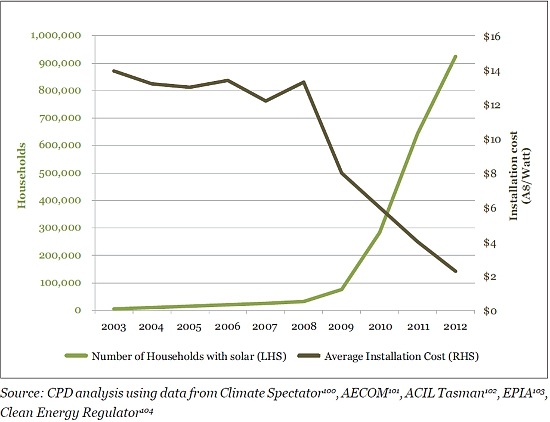In defence of solar
The think tank Centre for Policy Development has released a report, Going Solar, which provides a vigorous defence of government policy support for solar PV.
The CPD argues that government support for solar should be seen within a far broader and longer term context than many policymakers and media commentators have taken in recent times.
While support for solar per unit of electricity generated has historically been high, the authors, Laura Eadie and Cameron Elliott, argue:
-- The technology is widely expected to play a vital role in decarbonising our electricity system in the coming decades;
-- The technology has delivered on its promise of reduced costs, almost being too successful;
-- It helps insulate all consumers (not just those with PV on their roof) from foreseeable electricity price shocks due to gas price rises and cooling water scarcity (as occurred in 2007 due to the drought);
-- It is competing in a market that is not really an even playing field.
In many respects the report is a useful recap of a range of evidence that will be familiar to long-time readers of Climate Spectator.
Solar PV has delivered on purpose of policy support
Eadie and Elliott contend that policy support for solar has to some extent been a victim of its own success. A rapid fall in the cost of solar from 2008 helped stimulate installations but led to a blow-out in the cost of government solar support schemes, thereby attracting considerable criticism and abrupt policy changes.
Yet Eadie and Elliot point out that without the benefit of hindsight, predicting such a dramatic change in solar prices and consumer uptake would have been very difficult.
Average installed price and number of households with solar

The ultimate outcome from this policy is a good one, the report notes, with solar becoming far more widespread and affordable. Exactly the original purpose of the government policy support.
Solar has delivered an important hedge against price spikes for non-wealthy households
Contrary to the popular myth, solar, in the authors’ words, “buys mortgage belt insurance, not inner city votes.” Based on the data illustrated below, support for solar hasn’t been a subsidy to the rich to salve their environmental conscience, but rather is being used by less wealthy rural and mortgage belt households as a hedge against soaring electricity prices.
Income and solar uptake by urban classification

Source: CPD analysis of data from the REC Agents Association
This hedging benefit should extend beyond the consumers that have installed solar on their roofs. In support of this claim they reference analysis by University of Melbourne researcher Dylan McConnell, which found that Australia’s current level of rooftop solar is likely to have reduced wholesale electricity revenues by $300 to $670 million, or 4 to 7 per cent based on prices in 2009-2010.
Electricity not a fair and even playing field
Lastly Eadie and Elliott argue that solar is operating within a market that is not free of market power and distortions and so solar is not able to operate on an even playing field.
There is the $1 billion in per annum assistance coal generators receive as part of the carbon pricing package and $2.4 billion in unrecovered health costs they impose on the community. This is not to mention below market coal prices some government-owned coal generators enjoy.
Also there is an imbalance in negotiating power between solar households and electricity retailers. The market is highly concentrated with just three retailers dominating.
In the case of NSW, in spite of the regulator IPART estimating that retailers receive a benefit from solar generation in the realm of 7.7 to 12.9 cents per kilowatt-hour, every retailer bar AGL pays the bottom of the range or lower, with several offering no payment at all for exported generation.
On top of this, network companies are still yet to offer (and the regulators have failed to require them to offer) tariffs that would recognise the benefit of exported generation during periods when local network capacity is constrained.
NSW regulator’s estimate of wholesale value from solar PV generation and retailer offers

Source: CPD
Recommendations
The report makes a range of recommendations of which perhaps the most important are:
1. In light of the imbalance in bargaining power between utilities and consumers, regulators need to be involved in setting tariffs for exported generation from solar including provision of incentives to reduce expenditure on network expansion.
2. Further research is required to better understand how to accommodate high penetrations of solar PV in Australian distribution networks while maintaining power quality.
3. There is a need to consider how to assist renters and very low income households to share in the benefits from solar PV.
















